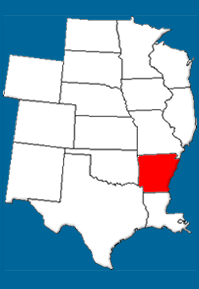 History:
In 1541, the Spanish explorer Hernando De Soto was the first European to set foot in Arkansas, as he led an unsuccessful, yearlong expedition for gold. After this failure, it was 130 years before two Frenchmen, Pere Marquette and Louis Joliet visited Arkansas. In 1682, at the mouth of the Mississippi, Rene-Robert Cavelier, Sieur de La Salle claimed the Mississippi Valley for France, but he was later assassinated by two of his companions. In 1686, Henri De Tonti set out from Fort St. Louis on the Illinois River to meet LaSalle at the mouth of the Mississippi. After he failed to locate LaSalle, De Tonti, the "Father of Arkansas," established the first European settlement in Arkansas, called Arkansas Post, with six residents.
Over the next hundred years, development of the region was sluggish as the number of settlers slowly increased. In 1762, the entire Louisiana Territory was ceded to Spain, and Spanish governors offered free land and no taxes to encourage settlers to inhabit the area. In 1799, there were approximately 386 white people living in Arkansas. In 1800, France regained control of the territory as part of a treaty signed with Spain. In 1803, the Louisiana Purchase was acquired by the United States, and, in 1819, Arkansas was organized as a territory. Its northern, eastern and southern borders were the same as they are now, but to the west, some of what is now Oklahoma was included.
By 1836, the Arkansas Territory had the 60,000 residents required to become a state, and after writing an acceptable constitution, was declared the 25th state in the United States. The new state enjoyed a thirty-year period of prosperity.By 1860 Arkansas had a population of 435,000, 25 percent of whom were slaves. The majority of the residents were planters who lived in the rich bottomlands of the east and southeastern portion of the state and farmers who lived in the central and northern hills. A much smaller number of residents were lawyers, doctors, merchants, missionaries and teachers.
Arkansas was drawn into the Civil War in May, 1861, by its decision to secede from the Union. Troops were mustered and civilians devoted their energy and resources to providing food, clothing, weapons, and horses for the soldiers. Two major battles, Pea Ridge and Prairie Grove, were fought in Arkansas. In 1863, the Confederate government moved to Washington, in the southwestern corner of Arkansas, and, in 1864, the Union government was established in Little Rock. After the Civil War ended in 1865, the era called Reconstruction began, during which dramatic changes took place in the South. |









